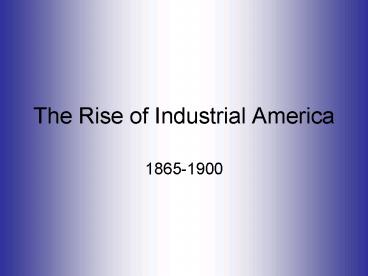The Rise of Industrial America - PowerPoint PPT Presentation
1 / 29
Title:
The Rise of Industrial America
Description:
... Social Darwinism = favorable public opinion Thomas Edison Menlo Park Laboratory Electricity Electric Light Bulb General Electric Power Plants ... – PowerPoint PPT presentation
Number of Views:98
Avg rating:3.0/5.0
Title: The Rise of Industrial America
1
The Rise of Industrial America
- 1865-1900
2
Industrial Growth 1865-1900
Causes
US has wealth of natural resources Explosion of inventions better business and manufacturing efficiency Growing urban population provides workers and markets RR establish new markets - spur business growth
Industrial Growth
Effects
Big business emerges Business consolidates under monopolies and trusts Workers endure harsh conditions Labor unions develop Major strikes by industrial workers violence
3
Important individuals in the late 1800s
4
Growth of Big Business Causes
- Technological boom
- Heavy investment in technology
- RR encourage expansion of business
- Social Darwinism favorable public opinion
5
Railroads Create National Network
- After the Civil War rail tracks started to follow
a standard tracks and signals. - The key event to the rail expansion was the
Transcontinental Railroad Railway that traveled
from coast to coast. - Railroads adopted time zones in 1883.
6
Thomas Edison
- Menlo Park Laboratory
- Electricity
- Electric Light Bulb
- General Electric
- Power Plants
- Grammaphone
- Prolific Inventor
7
The Bessemer Process
- Process allowed for the mass production of steel.
- Steel became cheaper and more available.
- With steel in greater supply new building
projects were undertaken. - The Brooklyn Bridge became the symbol of the new
era of American technological innovations.
Henry Bessemer
8
Growth of Big Business Methods
- Vertical integration (Carnegie Steel)
- Horizontal consolidation integration (Standard
Oil) - Trusts
- Economies of Scale
- Monopolistic tendencies
9
The Big Business Model
- Businesses in the late 1800s transformed into a
completely new form because of many factors - Larger Pool of Capital (Money) businesses needed
large amounts of money to run. Turned to private
investors. - Wider Geographic Span railroads allowed
businesses to have operations throughout the
country. - Broader Range of Operations Became responsible
for all stages of operation. - Revised Role of Ownership Owning and management
became two different things. - New Methods of Managements Specialized
departments (HR, Accounting, Security, Benefits)
were created to manage such large companies.
What it takes to run a large company.
10
Rockefeller Carnegie
- John D. Rockefeller Formed Standard Oil Company
in 1870 and soon became one of the worlds
richest men. - Business tactics were questionable.
- By the end of his life he gave 500 million in
charity to help fund social well being. - Andrew Carnegie Became the main supplier of
steel in U.S. in late 1800s. - Believed in Gospel of Wealth
- Gave away 80 of fortune to education alone.
He was no Santa Clause
11
Which one?
- Captains of Industry
- Robber Barons
12
Horizontal Consolidation
13
Vertical Integration
14
Growth of Big Business Features
- Large pools of capital
- Wider Geographic reach
- Changed role of ownership - professional
managers - New administrative techniques
- Oligopoly
- Robber Barons or Captains of Industry ---
Industrial Statesmen?
15
Corporate Structure
16
Growth of Big Business Government Relations
- Government
- Friendly to big business
- Minimal interference (laissez-faire hands off)
- Sherman Antitrust Act (1890) - first used against
labor unions NOT big business. (Would later
change)
17
Bosses of the Senate
18
Growth of Big Business Effects I
- US becomes industrial power internationally
- Many jobs available for immigrants failed
farmers - Better business efficiency
- Higher productivity
- Business cycles Boom and Bust
- Social class of super rich is created
- Income gap grows wider
- Labor Unions increased presence
19
Growth of Big Business Effects II
- Increased number of workers decreased wages
(generally) - Families work
- Increased mechanization less need for human
labor
- No insurance or benefits for most industrial
workers - Child labor
- Poor conditions bad health of workers
20
Boom and Bust Cycles
21
Gradual Shift to Industrialized Labor
22
Child Labor
23
Child Labor 1870-1930
24
Major Labor Strikes of the Late 19th century
(1870s-1890s)
25
Social Darwinism
- Big businessmen began to adopt Social
Darwinism. - An extension of Darwins natural selection
process. - Social Darwinists argued that society should
interfere with competition as little as possible. - Believed government should stay out of businesses
who were most fit to succeed and become rich. - Believed society would benefit from the success
of the fit by weeding out the unfit.
26
(No Transcript)
27
(No Transcript)
28
(No Transcript)
29
(No Transcript)































